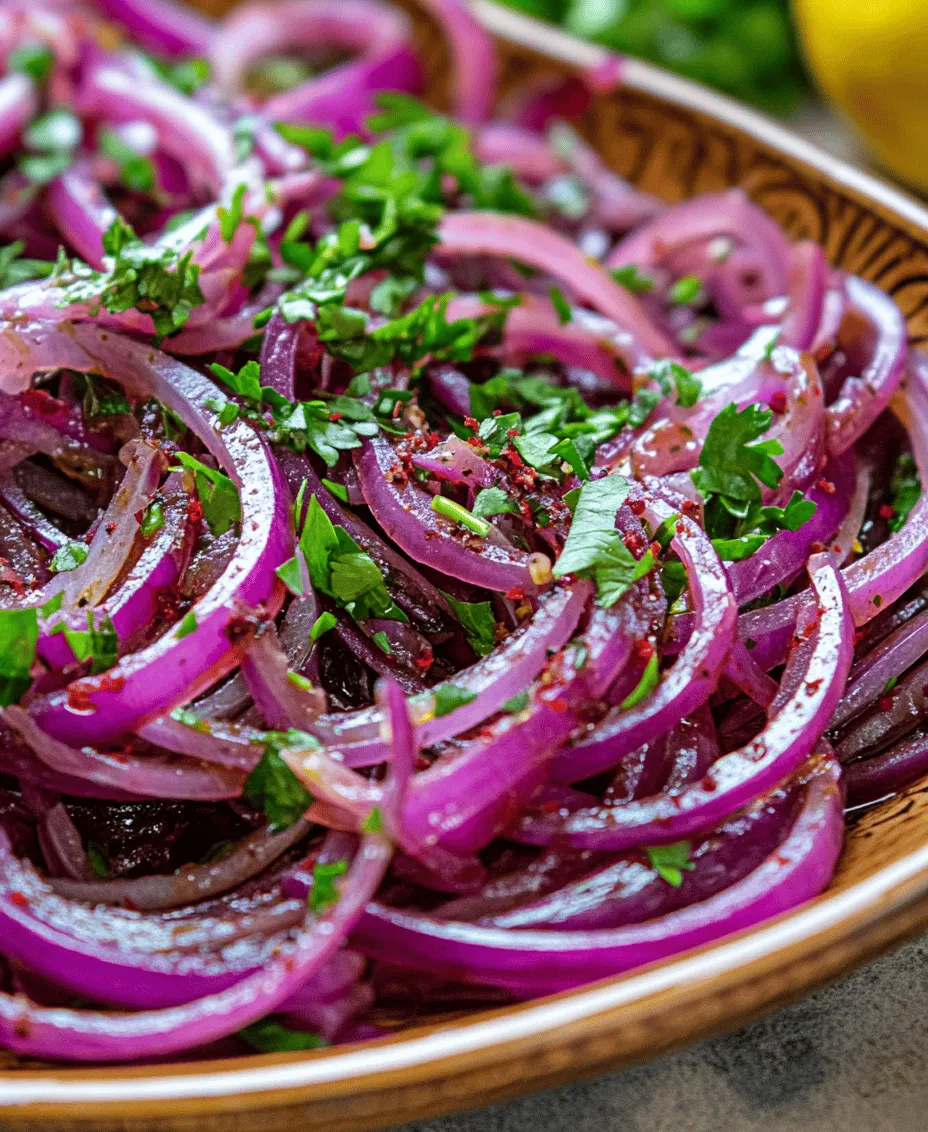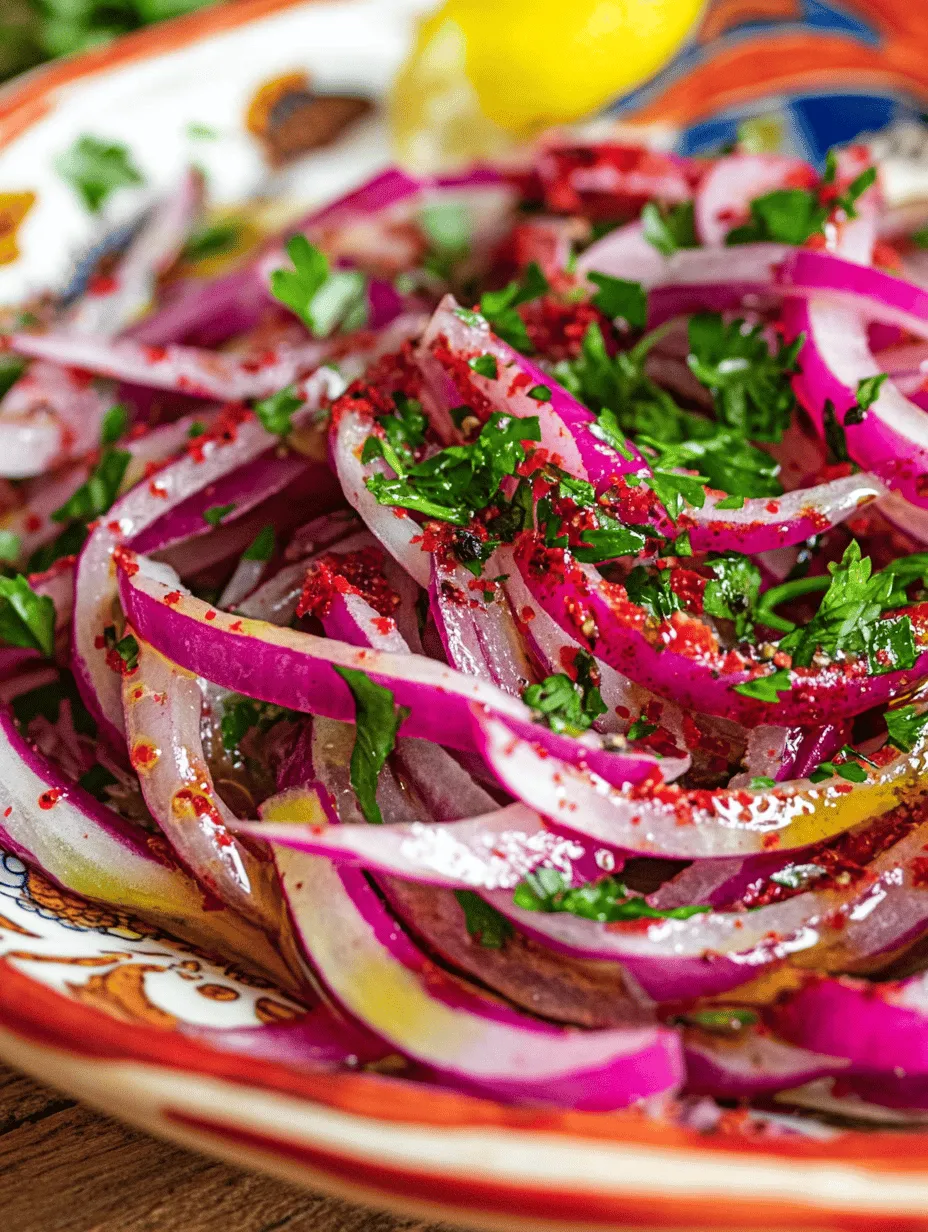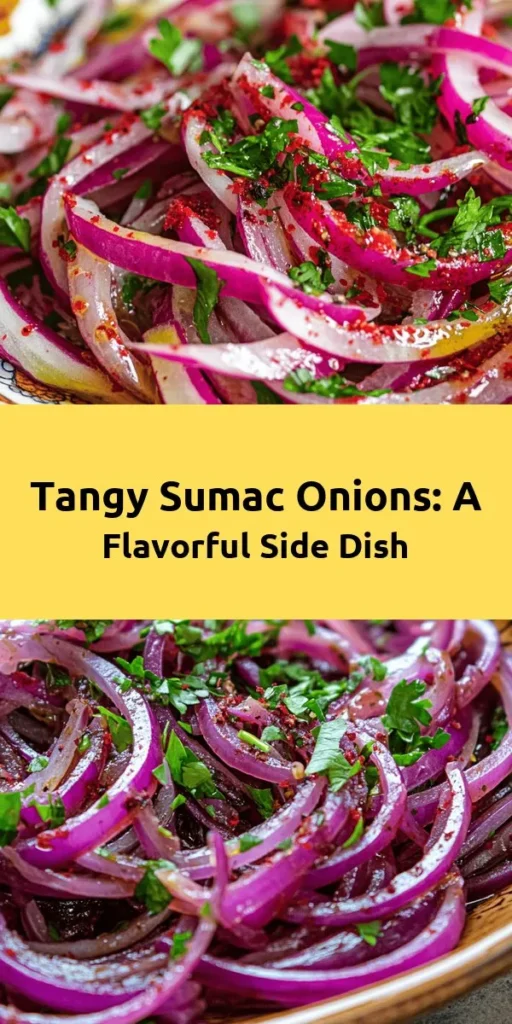Introduction to Zesty Sumac Onions
In the world of culinary delights, few combinations are as refreshing and vibrant as Zesty Sumac Onions. This dish is a perfect harmony of flavors that can transform any meal into a gourmet experience. The sharpness of red onions, coupled with the tangy essence of sumac, creates a unique taste profile that enhances everything from grilled meats to fresh salads. Whether you’re hosting a gathering, enjoying a casual family dinner, or simply looking to elevate your everyday meals, Zesty Sumac Onions are an ideal accompaniment.
The beauty of this dish lies in its simplicity. With just a handful of ingredients, you can achieve a burst of flavor that delights the palate and adds a splash of color to your plate. Sumac, a prominent spice in Middle Eastern cuisine, brings a bright, citrusy tang that pairs beautifully with the natural sweetness of red onions. This recipe not only showcases the versatility of these ingredients but also celebrates the rich cultural heritage behind them.
As we explore the preparation of Zesty Sumac Onions, we will dive into the core components of this dish, discussing their significance and how they come together to create a memorable culinary experience. Following that, we’ll guide you through the preparation steps, ensuring you can replicate this delightful recipe in your kitchen.
Understanding the Ingredients
The Core Components of Zesty Sumac Onions
To achieve the perfect Zesty Sumac Onions, it is crucial to understand the role of each ingredient. Here’s a closer look at the essential components that make this dish so special:
– Red Onions: As the star ingredient, red onions are known for their sweet flavor and slightly pungent aroma. They are milder than yellow onions, making them an excellent choice for raw dishes. Their vibrant purple skin adds a pop of color, making your dish visually appealing.
– Sumac: This Middle Eastern spice is derived from the dried and ground berries of the sumac plant. It is renowned for its tangy, lemony flavor, which provides a refreshing contrast to the sweetness of the onions. Sumac not only enhances the taste but also adds a beautiful red hue to the dish.
– Olive Oil: A staple in Mediterranean cooking, olive oil is used for its rich flavor and health benefits. It serves as the base for the dressing, helping to meld the flavors of the other ingredients while providing a smooth texture.
– Lemon Juice: The acidity from lemon juice is vital for balancing the richness of the olive oil. It brightens the overall flavor profile of the dish and enhances the tangy notes of the sumac.
– Honey: While optional, a drizzle of honey can add a subtle sweetness that complements the tanginess of the sumac and the sharpness of the onions. This balance of flavors is what makes Zesty Sumac Onions truly unique.
– Fresh Parsley: As a garnish, fresh parsley not only adds a splash of green but also contributes a fresh, herbaceous note that brightens the dish. It’s a perfect finishing touch that enhances both the presentation and flavor.
Preparation Steps
Now that we’ve covered the essential ingredients, let’s dive into the preparation steps for crafting Zesty Sumac Onions. Proper preparation is key to unlocking the full potential of this dish, so let’s take it one step at a time.
Preparing the Onions for Maximum Flavor
The first step in creating Zesty Sumac Onions is to prepare the red onions. Here’s how to achieve the perfect slices:
1. Peeling the Onions: Start by removing the outer skin of the red onions. A sharp knife will make this task easier. Once peeled, rinse the onions to remove any residual dirt or skin fragments.
2. Slicing the Onions: For Zesty Sumac Onions, you want to slice the onions thinly. Aim for about 1/8 inch thick slices. This thickness ensures that the onions will marinate well and absorb the flavors of the dressing. To achieve even slices, use a sharp knife and cut through the root end of the onion. If you’re not confident in your knife skills, a mandoline slicer can also be a great tool for uniform slices.
3. Soaking in Water (Optional): If you find red onions to be too pungent for your taste, consider soaking the sliced onions in cold water for about 10-15 minutes. This process helps to mellow their sharpness. After soaking, drain and pat the onions dry with a paper towel to remove excess moisture.
Crafting the Perfect Dressing
With the onions prepared, the next step is to create a flavorful dressing that will elevate your dish:
1. Mixing the Ingredients: In a small bowl, combine the olive oil, sumac, lemon juice, and honey (if using). Start with about 3 tablespoons of olive oil and 2 tablespoons of lemon juice. Add 1-2 teaspoons of ground sumac, adjusting to your taste. If you decide to include honey, start with 1 teaspoon and increase as needed, depending on your preference for sweetness.
2. Balancing Flavors: Whisk the mixture until well combined. The goal is to achieve a harmonious balance between the rich olive oil, tangy lemon juice, and the sharpness of the sumac. Taste the dressing and adjust as necessary, adding more lemon juice for acidity or more sumac for tanginess.
3. Texture Considerations: The dressing should be smooth and slightly thickened, with the sumac suspended throughout. This consistency ensures that every bite of onion is coated in flavor.
Combining and Marinating for Optimal Taste
Now that you have your onions sliced and your dressing prepared, it’s time to bring everything together:
1. Tossing the Onions: In a large mixing bowl, add the sliced onions. Drizzle the prepared dressing over the onions and use your hands or a spatula to gently toss them together. Ensure that each slice is evenly coated in the dressing, which will enhance their flavor and texture.
2. Marinating Time: For the best results, allow the onions to marinate for at least 30 minutes at room temperature. This step is crucial as it allows the onions to absorb the flavors of the dressing and become tender. The acidity from the lemon juice will also help to mellow the onions further, making them more palatable.
3. Final Touches: After marinating, taste the Zesty Sumac Onions once more. If desired, garnish with freshly chopped parsley for added freshness and an appealing visual contrast.
By following these steps, you’ll create a vibrant dish that not only enhances your meals but also serves as a delightful addition to any gathering. The next section will delve into serving suggestions and additional tips for making the most of your Zesty Sumac Onions, ensuring they become a staple in your culinary repertoire.

Serving Suggestions
Versatile Uses for Zesty Sumac Onions
Zesty Sumac Onions are not just a standalone dish; they can be integrated into various meals to elevate flavors and enhance the dining experience. Here are some creative ways to enjoy this vibrant dish:
– As a Standalone Side Dish: The tangy flavor of Zesty Sumac Onions serves as a refreshing complement to a wide range of main courses. They pair wonderfully with roasted vegetables, grains like quinoa or rice, or even alongside simple protein dishes like grilled chicken or fish. The acidity of the onions cuts through the richness of the meat, providing a delightful contrast that makes every bite more enjoyable.
– Topping for Grilled Meats: These zesty onions are an excellent topping for grilled meats, adding a burst of flavor that enhances the overall taste of the dish. Consider serving them atop skewers of grilled lamb or chicken, or as a garnish for beef kebabs. The acidity of the sumac and the sweetness of the onions create a harmonious balance that complements the smoky flavors of grilled foods.
– Inclusion in a Mezze Platter: Zesty Sumac Onions can be a star player on a mezze platter, a traditional Middle Eastern spread featuring a variety of small dishes. Pair them with hummus, baba ghanoush, tabbouleh, and pita bread for a delightful assortment that showcases the vibrant flavors of the region. The tangy onions provide a refreshing contrast to the creamy dips, making them a perfect addition to your appetizer spread.
Culinary Significance of Sumac
A Brief History of Sumac
Sumac has a rich history rooted in Middle Eastern cuisine, where it has been used for centuries not only as a spice but also for its medicinal properties. The sumac plant, which produces deep red berries, has been ground into a fine powder that is used to impart a tart, lemony flavor to dishes. Traditionally, it was used to add acidity to meals before the widespread use of lemons in cooking.
In addition to its culinary uses, sumac is known for its health benefits. It is rich in antioxidants, which help combat oxidative stress in the body. Sumac is also thought to have anti-inflammatory properties and may aid in digestion, making it a valuable addition to a healthy diet.
The Role of Onions in Global Cuisines
Onions are one of the most versatile ingredients used across the globe, featuring prominently in cuisines from every corner of the world. They are a staple in cooking, valued not only for their flavor but also for their ability to enhance and elevate other ingredients in a dish. From French onion soup to Indian curries, onions form the foundation of countless recipes.
Culturally, onions hold significance in various traditions. In many cultures, they symbolize prosperity and health. They are often used in celebratory dishes, signifying abundance and flavor. Their ability to caramelize and deepen in flavor when cooked makes them a beloved ingredient in both sweet and savory dishes.
Nutritional Information
Understanding the Health Benefits
Zesty Sumac Onions are not only delicious but also packed with nutrition. The primary ingredients—onions and sumac—offer numerous health benefits.
– Onions: Rich in vitamins C and B6, onions also provide essential minerals like potassium and manganese. They are a great source of dietary fiber, which supports digestive health. The antioxidants found in onions, particularly quercetin, are known for their anti-inflammatory properties and may help reduce the risk of chronic diseases.
– Sumac: In addition to its distinctive flavor, sumac is known for its high antioxidant content. It contains compounds that may help lower blood sugar levels and improve heart health. Sumac has also been traditionally used to relieve digestive issues and promote overall wellness.
Incorporating Zesty Sumac Onions into your diet can add flavor while providing a boost of essential nutrients, making them a valuable addition to a balanced meal plan.
Conclusion: Embracing Flavor with Zesty Sumac Onions
Zesty Sumac Onions offer a delicious and healthy way to elevate your meals. With their unique flavor profile and versatility, this dish is not only easy to prepare but also brings a taste of Middle Eastern cuisine to your table. Whether served as a side dish, topping for grilled meats, or as part of a mezze platter, these marinated onions are sure to impress and satisfy your taste buds.
Incorporating this recipe into your culinary repertoire not only enhances your meals but also introduces you to the diverse flavors of the world. So, gather your ingredients, embrace the wonderful tang of sumac, and enjoy the journey of creating and savoring this delightful recipe!



